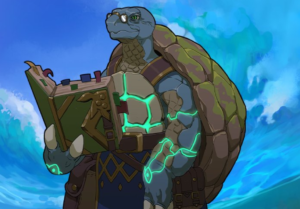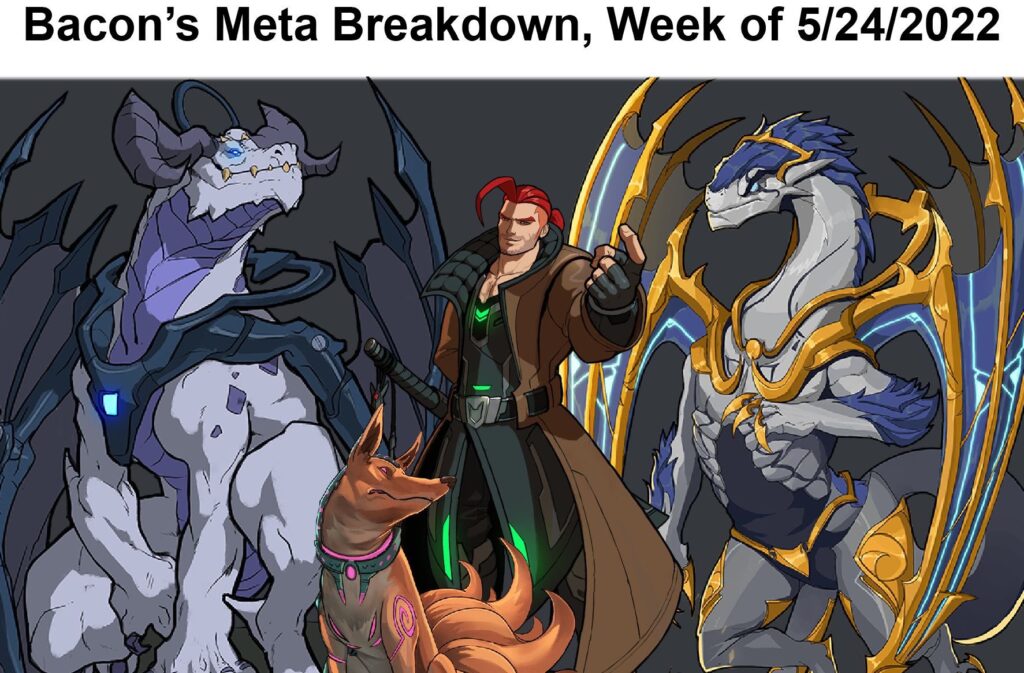
Howdy y’all, alliteration addict Just Add Bacon here, happily and decisively delivering the May meta report. This month we’ve seen a rather marvelous development in the Skyweaver metagame, as this is the first meta I’ve seen where one could definitely claim that midrange is the dominant strategy. In builds like Sitti, Horik, and Mira midrange tactics have taken center stage, and other decks such as Axel and Titus Genesis, Fox, and Zooey have been forced to adapt. So, without further ado, let’s break it down!
Disclaimer: How to read the report
 This report was constructed through two surveys. In the first survey, high-level Skyweaver players were asked for each hero to list whether or not they had an Aggro, Control, Midrange, Combo, or other deck that was relevant in the current constructed meta (Ladder, Conquest, and Competitive Tournament Play). The lowest half of the suggested decks were cut and the rest were added to a second survey. In this part, respondents were asked to name the tier(s) in which each deck could be reasonably placed. These tiers were given scores of 4 for S tier, 3 for A tier, 2 for B tier, and 1 for C tier. Additionally, a plus or minus (+/-) added to the tier increased or decreased the score by .3 (for example, an A+ tier would have a score of 3.3). The highest and lowest scores were dropped (to reduce variance) and scores were used to calculate a weighted average, which is the score listed next to each deck. The decks were then sorted into (nearly) equal groups to create the relative tiers for the previous meta.
This report was constructed through two surveys. In the first survey, high-level Skyweaver players were asked for each hero to list whether or not they had an Aggro, Control, Midrange, Combo, or other deck that was relevant in the current constructed meta (Ladder, Conquest, and Competitive Tournament Play). The lowest half of the suggested decks were cut and the rest were added to a second survey. In this part, respondents were asked to name the tier(s) in which each deck could be reasonably placed. These tiers were given scores of 4 for S tier, 3 for A tier, 2 for B tier, and 1 for C tier. Additionally, a plus or minus (+/-) added to the tier increased or decreased the score by .3 (for example, an A+ tier would have a score of 3.3). The highest and lowest scores were dropped (to reduce variance) and scores were used to calculate a weighted average, which is the score listed next to each deck. The decks were then sorted into (nearly) equal groups to create the relative tiers for the previous meta.
 Given that this report only addresses this meta, it’s important to note how the scores relate in relative and absolute terms. The difference between the scores of the two decks represents the rough gap in power between the decks. The absolute score of the deck represents its strength in a vacuum. For example, the majority of decks that ultimately made it in C tier have scores that would correlate more towards B tier. They are, however, in C tier due to their relative power with the other decks considered in this report. There is also a Confidence Interval next to each deck, although this data is anecdotal, not empirical. Roughly, it correlates to the spread in the data. The more “tight” the data, the higher the confidence interval. Conversely, the more varied the opinion on a deck’s strength, the lower the confidence interval.
Given that this report only addresses this meta, it’s important to note how the scores relate in relative and absolute terms. The difference between the scores of the two decks represents the rough gap in power between the decks. The absolute score of the deck represents its strength in a vacuum. For example, the majority of decks that ultimately made it in C tier have scores that would correlate more towards B tier. They are, however, in C tier due to their relative power with the other decks considered in this report. There is also a Confidence Interval next to each deck, although this data is anecdotal, not empirical. Roughly, it correlates to the spread in the data. The more “tight” the data, the higher the confidence interval. Conversely, the more varied the opinion on a deck’s strength, the lower the confidence interval.
However! All of this was done with a survey size of 12. The opinions used to create this report represent a very small number of players in a rapidly developing meta. So don’t be afraid to try things out that are “weak” or “off meta”! Who knows, you might discover something that makes it onto the next report
Side Note: There are less decks than normal as the meta has become slightly homogenized. Therefore, the tiers are smaller than on the average report.
S Tier
SWxHRI02arcip7JAb9DgboHwMEYEFQkjyqmhhdUbG5ShAvesfPPSkJqMnDsyhidB7Gy6oSnCr7Y63RbY1U7mW7JMmZ
SWxSTH022x4dbscPTAdKwjKouim3UGqmvLmkWbhtC46Dhs3TdeD94QmUhC9k8inc1Aqrikt8Ps1T6BuM3JxmBxHj7R
SWxSTW02BHGN4nPH7DtoLW4NfGzN8uKR7aXZsN6CPfoqCGWFo8QigAriYv872Ge48EmnyKCrb4coKSS3bBL3nThj5

To begin, I think a deeper understanding of midrange than what was presented in the previous report would be helpful. Midrange decks are most commonly thought of as existing somewhere in-between the other two main archetypes, aggro and control. While aggro decks are defined by their aggression, and control is defined by its attempt at controlling aggro, midrange is distinctly neither of these things. Instead, midrange focuses on ideas of tempo, efficiency, and board control. 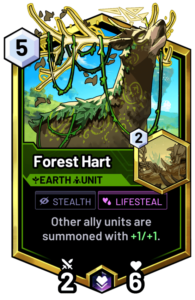
For any midrange deck, there are two competing problems that it must attempt to solve at the same time. The first of these is controlling aggro despite being slower. Normal control decks work against aggro through a combination of efficient removal tools, better draw engines, and a mix of healing, stalling, and hard to answer finishers. Of course, the first instinct for beating aggro may be to just run all of these, but midrange has a second goal: midrange decks attempt to be able to control aggro while still being fast enough to rush down control. This is where midrange decks become interesting.
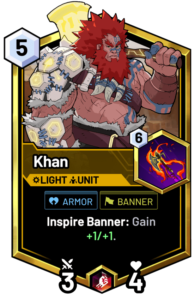 Because midrange is attempting to beat both aggro and control, its cards are inevitably pulled in two directions. Therefore, it makes a lot of sense that the typical options ran in midrange decks are cards that can work well in either matchup. Efficient removal tools and hard to answer finishers are part of the package, but efficiently statted units fill out the bulk of the deck. This works for a couple of reasons. First, in your generic matchup, the overstated units that midrange employs can generally trade through aggro’s lower cost units. This allows them to function as removal conditioned on board control, which is rather fine as aggro’s tools tend to be more focused on cost efficiency rather than removal efficiency. Many of these midrange units also have additional traits, such as banner, armor, and guard, that also help even the field against aggro.
Because midrange is attempting to beat both aggro and control, its cards are inevitably pulled in two directions. Therefore, it makes a lot of sense that the typical options ran in midrange decks are cards that can work well in either matchup. Efficient removal tools and hard to answer finishers are part of the package, but efficiently statted units fill out the bulk of the deck. This works for a couple of reasons. First, in your generic matchup, the overstated units that midrange employs can generally trade through aggro’s lower cost units. This allows them to function as removal conditioned on board control, which is rather fine as aggro’s tools tend to be more focused on cost efficiency rather than removal efficiency. Many of these midrange units also have additional traits, such as banner, armor, and guard, that also help even the field against aggro. 
All of that said, how does the deck function versus control? Against control, midrange continues to put reliance into its well statted units, with its removal tools just working as weaker versions of aggro tools. Additionally, while aggro may focus on speed to answer control, midrange instead focuses on resilience. Because control has to contend with aggro decks, their removal options may consequently be too weak to answer the better statted units of midrange decks. Additionally, many units employed by midrange decks (consider {{Geod}}, {{Khan}}, {{Roothog}}, {{Eclipse}}, {{Righteous}}, {{Great Gusto}}) have unique properties that make them more resistant to traditional removal tools, either by reducing their efficiency, resisting or dodging the removal, or both. Because of this interplay, midrange is more favored against control decks as their removal options become worse for dealing with its units, and visa versa.
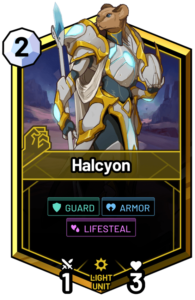
In practice, a midrange deck can be identified by a couple of important qualities. For starters, the bulk of the deck’s gameplan will be placed in its units. While an aggressive deck may consider its units mostly interchangeable bits of face damage, and control considers its units for their ability to generate value and tank damage, units are the beginning and end of the midrange deck’s gameplan. Secondly, midrange decks, as the name would suggest, tend to occupy a middling curve between aggro and control. Measuring curves can be difficult in Skyweaver due to attached spells, but if the bulk of the deck’s important units are between 3 and 7 mana, it’s usually a midrange deck. Finally, a midrange deck almost always packs some finishers that are in the form of units. Midrange decks can employ burn options as finishers, but units are generally preferred for their effectiveness against aggro decks that struggle to remove them.

Now that we have a clearer image of midrange, how does it actually look in this meta? For starters, Horik and Sitti feature curves that look like textbook aggro, featuring large swaths of 1 and 2 cost units. Sharing the Heart prism, options like {{Shade}}, {{Crypto}}, and {{Icaru}} occupy the early game. Other prism specific tools like {{Halcyon}}, {{Sidekick}}, {{Shoal Siren}}, and {{Bubbles}} also play important roles. Both decks also utilize strong aoe options to wall out runaway aggro decks. Spells such as {{Frigid Blizzard}}, {{It’s a Trap!}}, {{Burninate}}, and {{Kha’s Wrath}} are powerful aoe spells, with the distinction being that Sitti’s are earlier while Horik’s have more power behind them. Finally, value-intensive units such as {{Gus}}, {{Eclipse}}, {{Chester}}, {{Bauble}}, {{Chief Justice}}, and {{Light Ranger}} provide on-board resistance against aggro’s tools by reducing the efficiency of their plays while finding a foothold to begin trading.
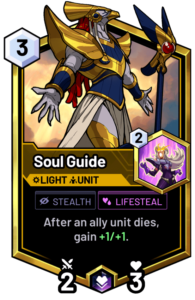
Perhaps the most interesting element of these decks is the finishers that they employ. Horik’s finishers are much more traditional. {{Khan}} can make a strong play on turn 5, especially when coupled with a {{Songbird}} from {{Gus}}, and if left unanswered can blow through units and hitpoints with his attached {{Catch!}} On nine is of course {{Pharonis}}, now returned to 7 health, making it much better at surviving common removal options from both aggro and control. Additionally, the bolstering the whole deck receives from the recently buffed {{Glorious Mane}} allows other units such as {{Soul Guide}} and {{Bard Rock}} to provide some final hurdles against both aggro and control. 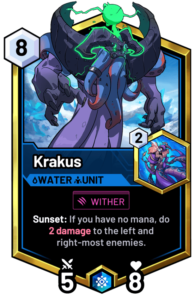
For lack of a better word, Sitti’s finishers tend to be more exciting. Aside from also being able to run Pharonis, the elephant in the room for Sitti is certainly {{Floodwater}}, and all the glorious tools it finds. For Sitti, Floodwater provides several functions. First, it guarantees inevitability in the aggro matchup. As long as Floodwater is drawn, its bounty of versatile removal and guard mean that, once the spell is cast, aggro has generally lost the game. Of relevance in the control matchup however is that Floodwater grants the deck a second attempt at making a game winning board, this time through the power of {{Sapphire}} + {{Bubbles}}. {{Frostmaiden}} can also be added, although this is usually not needed. If it is however, Frostmaiden will almost certainly get the job down. There is a weakness to this strategy though, and it is the same weakness all recursion based decks face. Since Bubbles and Sapphire are both units that will need to enter the discard pile, there are numerous opportunities for the deck’s finishers to be sniped by dusting. Of course, many decks may have trouble with this, but heroes like Axel can intercept with good enough accuracy, thanks to tools like {{Kha Meht}}, {{Raise Arms}}, and {{Burn to a Crisp}}.
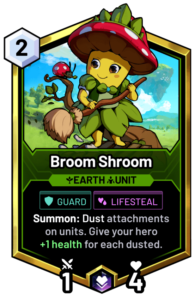
Finally, in both decks {{Undergrowth}} and {{Broomshroom}} have been found to make a potent combo against essentially the whole meta, only weak to spells like {{Burninate}}, {{Kha’s Wrath}} and {{Whelm}}. The combo works well for a couple of reasons. First, it’s 2 cards, and puts 4 on board. Traditional aoe trading into the spell goes +1 at best against the combo, but that’s both generally sacrificing both board and tempo, and an optimistic assessment. Units buffed from anima very rarely have less than 4 health, meaning that options like It’s a Trap and {{Frigid Blizzard}} are not effective in answering the play. Additionally, outside of aoe spells, board presence generally fails to find impact against the combo. Units recurred frequently cycle ({{Crypto}}) have guard ({{Halcyon}}) provide banner ({{Sidekick}}, {{Xcythe}}) or do some combination of all of those ({{Bauble}}, Gus, {{Light Knight}}, Bubbles). Against such an overwhelming force, aggro’s only hope is to quickly find lethal force. Even control decks can find issues with the sudden change in card advantage.
A Tier
SWxHRW02e3Txt7J4r7wbLPQcpQeMhwqzLDmi6mWzuUVywGNtB3ZBzfo9nq9HXHJVrGtT6QpZd9cphg6F2g5ebPsXvb
SWxAGW02ieYWNU3yZFzB2YD34DfmZLMyktk49XDHa8K18Qf2H47sxrKY986d2vmvxSQuvEJprZGDx3fjR2BEZLaxfR
In A tier I’ve reserved the conversation about Titus Genesis, if only for the ease of discussion. Iris Lion Combo has also somehow found a way to always exist at the same power level, so I will be keeping discussion of her brief.
![]()
Genesis Loops is the current dominant control deck in Skyweaver, and is in fact so dominant that there is not any competing control deck. The reason for this is rather simple. Genesis Loops play around infinitely looping either {{Soul Forge}} or {{Eldest}} (who’s attachment is Soul Forge) with the unit {{Genesis Avatar}}. Genesis, upon dying, recycles 7 other tools along with the looping card, frequently granting access to cards like Kha’s Wrath, {{Seal of Doom}}, {{Windweave}}, and {{Ponderous}}, allowing the deck to remove any board while also continuing to gain card advantage. 
The question for every game involving Genesis Loops is when the deck will be able to start its combo. Once the combo is going, even the value contained in spells like Floodwater quickly becomes outpaced. This is why non-Genesis control decks simply can’t beat Genesis loops by traditional means. The wincon for a traditional control deck is card advantage, pure and simple. But, against a deck with infinite card advantage, while suffering the drawbacks of an ood war, a control deck is put at the rawest disadvantage. Of course, options like Fireball spam, or copies of {{Sky Phoenix}} could be attempted, but at this point on sacrifices much against other decks in the meta, begging the question of why not just play Genesis and take the mirror match? 
Thankfully, against non-control decks the picture is not so bleak. Both Aggro and Midrange can regularly win against Genesis, although Genesis has fantastic tools for stopping the decks dead. Universal to Titus and Axel are powerful ramping options like {{Take Root}} and {{Gift of Aya}}. Both of these provide healing, and Gift of Aya can even find other utility options like {{Nature’s Grasp}}, {{Chomp}}, or even just Take Root. Early ramp spells can generally be a death sentence for aggro decks, as they weaken the limitation aggro relies so much upon, the opponent’s limited mana. Against midrange ramping is not as decisive, but can still be powerful, allowing options like Burninate or Kha Meht to seize control of the board sooner than normal. 
Chiefly impactful in both decks is access to {{Hydrate}}, Whelm, Kha’s Wrath and {{Forest Fire}}. Having played both decks to the point of winning a legacy skin, I would argue that the choice between heroes largely revolves around which one makes better use of the two main wisdom spells, and whether Kha’s Wrath or Forest Fire is better against the meta. Hydrate serves several functions for the deck. First and foremost, it is a massive reload tool, granting the equivalent of a {{Blitz}} in new cards at only 1 mana. Even when played as a -1 this can still be massively impactful. More destructive however is its utility as a disruption tool. Whenever the opponent is holding 6 cards or more Hydrate begins to overdraw the opponent’s hand, slowing down their deck in a number of ways. First, any answers or combo pieces that had been saved have been removed from their hand, generally interrupting their flow of play. In the cases of tools like {{Undergrowth}}, Kha’s Wrath, or Genesis Avatar being returned, the effects can put the opponent behind for several turns. Secondly, the card being reshuffled also reduces the consistency of the deck, meaning that, even though they will draw it again, it may be drawn at the wrong time, or when another card needs to be drawn instead. Individually, the effects from these reshuffles may be small. Over 50, or 100 games however, and the minor differences begin to add up into wins. 
Most potently, Hydrate has disgustingly powerful synergy with options that keep the opponent’s hand large, allowing it to potentially go as far as being a +2 for 1. Units like {{Turtor}}, {{Homebrew}}, and {{Xavi}} help achieve this passively while providing other utility. Whelm also deserves particular mention, as it is capable of achieving this while also being individually useful. Whelm’s role in most Genesis loop decks is answering scary threats like cheap units buffed by {{Jungle Guide}}, or the aforementioned Undergrowth + Broom Shroom play. Interestingly, just the existence of Whelm helps buey the decks against Horik and Sitti, as they are generally forced to delay their draws and play out their hands as much as possible, lest they lose the value and tempo entirely to a 2 mana spell. When Whelm is eventually played however, it often works as a punish against Horik and Sitti for maintaining a board and a hand, as it is rather easy for the decks to quickly become overloaded against the spell. 
The last deck in A tier needs no introduction, as her game plan is still largely the same. The introduction of {{Swarmsinger}} has given Iris a new tool for slowing down aggro decks, but other than that she mostly preys on slower Genesis builds to take her wins. Against the more common midrange builds options like Whelm and {{Maelstrom}} prove handy, but are not the most reliable as {{Mer Mask}} has conflicting search targets. Nevertheless, Iris continues to be a consistent deck that checks the worst excesses of control, while also occasionally pounding aggro.
B Tier
SWxSTA02XqT3LUVBNUjLePaAa3CFFwRuZbWvSzZQeQ2YMnHy1sV85jvQDy9M7EFrevDNTftBHnG8hnVbBpuDTYkLs
SWxAGW02k4mfMD6k41ZZQvt5cChK3zoZKEadpQS5CCftojr6N2ipdXqsQzS7WKPtBtdV1togL5ZXZ3CtJr9Eowz3sd

Moving on to B tier we have our two aggro decks for the meta, Fox Burn and Iris Burn, and at this point it’s important to say that, at least in this meta, matchups are more important than average power. At this point power levels tend to become fairly closely grouped, meaning that individual card interactions and lines of play become the dominant factor. We can see this evidenced in Fox holding a slight edge over Iris, as Fox likely has better matchups against Horik and Sitti. However, other decks such as Mira, Banjo Etherwail, and Banjo Zam likely prefer dealing with Fox, rather than Iris and her hand disruption tools. 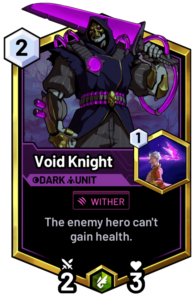
Fox Burn is an aggressive deck that steals many of its best plays from its midrange counterparts Horik and Sitti. Utilizing aggressively costed units such as {{Psyche}, {{Rubble Devil}}, {{Khan}}, {{Heavy Cavalry}}, and {{Geod}}, the deck aims to take control of the board by brute force, relying on stats and tempo to keep its units alive. As it does this, Agility’s trademark tempo tools control the enemy board, with tools like {{Honk}}, {{Hot Dog}}, and the newly buffed {{Void Knight}} taking center stage. Finally, for its finishers, Fox places heavy emphasis on burn effects, finding damage from cards like {{Chomp}}, Catch! {{Vlad}}, Kha’s Wrath, Khan, and potentially also {{Mothermander}}. Units such as Geod, {{Heavy Cavalry}}, and {{Mighty Steed}} generally tend to help this endeavor, but Fox doesn’t often find issue if they are missing. 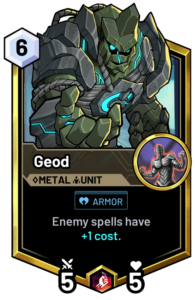
On the topic of them being missing, this is actually the question that keeps Fox lower in the tiers, at least in my opinion. While the deck packs a large number of powerful units, something it lacks, at least compared to Horik and Sitti, is draw power. True, Fox can pick up draws from a number of places; Psyche can dump a bad hand, {{Zapeta}} and Cavalry do it automatically, and Mighty Steed is about as reliable as any 6c unit can be. But, none of these cards draw at the same rate or quality as Horik Sitti do, nor do they curve out as quickly. So, while Fox can draw, his consistency is nowhere near as good as the competing midrange builds that are well suited to walling him out. This leaves Fox in an awkward state where he can bully through decks in the earlier turns of any match, but only on the condition that his draws are at least decent, and that his opponent’s are slow. 
In B tier we also have Iris Burn, a deck that’s been creeping around in the background of previous meta reports for some time now. Iris takes a similar path to the older versions of Fox Burn, sticking to a much lower curve and going much more directly for face damage. To this end, Wisdom presents a few unique tools that help differentiate it from Strength. 
For starters, the power of {{Turn the Tide}} (TtT) can not be underestimated. For any deck, the ability to potentially go +4 is big. {{Dreams Undreampt}} and {{Tempest Brew}} both present choices for +2, but a +4 draw is wholly unheard of until one gets to cards like {{Prismata}} and Floodwater. Additionally, the fact that this is pure draw, as opposed to targeted draw, dramatically helps the card by ensuring that it produces reliable deckthinning. What really makes TtT amazing though is its ability to do all of this at 0c while also disrupting the opponent’s hand. The idea of a player holding less than 5 cards is generally laughable in this meta, as even Fox decks generally muster that many. So, given this amazing tool, how does it work with the rest of the deck? Well, cards such as {{Eldritch Lore}}, Hydrate, and Xavi make it easy to find, meaning we can rely on having it ready the majority of the game. So, it then becomes very convenient to build a deck that places a lot of focus on tempo and converting cards into damage, and letting Turn the Tide dig up the missing pieces. 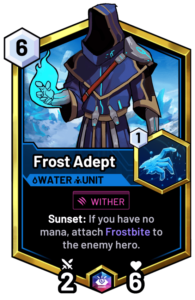
In this case, damage comes from numerous Agility tools like {{Speedster}}, {{Card Sling}}, and Mighty Steed. Wisdom also brings a good number of damage options. {{Frost Adept}} can be a game-winning tempo swing against heroes like Fox and Zoey, and when left unanswered the Frostbite often ends up translating into an extra ~8-12 damage. Against any hero this can be damning. Even if this doesn’t transpire, the costs of answering Frost Adept can still be high, and help decide the game in their own way.
C Tier
SWxSTI023JcwfZV7qCtjHM4vqkNyXUXs7z7KW9Gahg6izQdxeAYwL78JyYriEBZFB45hrP5FxP6wYxEpxLCvBWQW3Z
SWxINW02f78xEmpvZmnrHx6s5ZwGuvoWR2LpMj1DVggeH4eEW61dYbVDWH6jEq2tKaMnxhEqFFVYkCf9cZ8zjxG16f
SWxHRA02jXwEMxxB5d3PEZ2Sa3dyEs1Jt6ECAzjTe1ff8qGgaXkBY3sCA1RmL1hKiuYhqZM9ZadmWaHk3EfSeCa5w9
Finally, in C tier we have a collection of what are, according to the weekly stats from Horizon, the best decks in the game. However, this is clearly not what was found in the meta report surveying. Curious, isn’t it? 
Kicking us off is Mira Will, another Midrange deck, this time focused on utilizing {{Amaruath’s Will}}l. Will is a powerful build around spell, attaching anima to every unit in both hand and deck with no attachment. The buffs that come from this are quickly seized by Mira, who’s units and spells invariably replace their attachments. In the early game this is huge, as a +2/+2 buff quickly scales units beyond the standard removal. 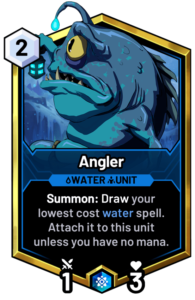
Having prisms from both Horik and Sitti, one might expect Mira to perform quite well. And, if one takes official stats, or the deck’s matchup spread into consideration, they might be right. But, Mira is not a flawless deck. For starters, while her odds of finding Will are good, they aren’t perfect. {{Angler}} can find {{Ari’s Insight}}, and with no other 3c options in the deck Insight will always find Will. But, this line of play immediately excludes Mira from strong options like {{Water Rune}} and {{Savage Garden}}. Additionally, while Mira can produce a great number of well statted units, her curve can come off as awkward at times, giving more aggressive decks like Fox and Iris Burn windows to punish her. Even if she does get her combos off, decks like Titus and Axel Genesis have all the tools they need to systematically remove her threats. 
In this tier we also have Banjo Etherwail and Zam. Etherwail garnered a 61.3% win rate in the weekly stats, confirming my theory of it being far stronger than what others believed. Patting myself on the back (like a good boy) aside, the deck revolves around lining up a powerful and early {{Etherwail}} turn to carry the game. In this deck, Etherwail is found commonly through {{Seek}}, which itself can be tutored by Angler, which itself is reliably found from {{Teleport}}. Needless to say, the deck is fairly consistent. Once Etherwail is played, the deck controls board through units like {{Cryogen}}, {{Amaruath}}, {{Krakus}}, and {{Enigma Golem}} (who usually finds {{Mass Confuse}}) until they win. 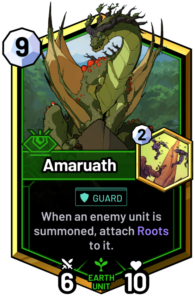
Against aggro decks, the combo is generally devastating. Hard removal spells to answer the units are accessible for every prism, but running these spells tends to present a trap. Due to their cost, spending them to address only half the units often ends up representing a lost turn, which the Banjo player can use to leverage other healing and removal options. Of course, killing the enemy Amaruath is generally better than not doing so, but once the Etherwail is played the Banjo player has already gained a sizable lead. 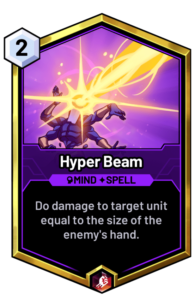
For Midrange and Control decks however, Etherwail presents much less of a problem. True, an early Etherwail can still be disastrous for these decks, but they stand much less to lose in taking the time to answer the opponent’s units. The Etherwail deck generally has a lot of defensive tools, and also a potential second Etherwail with Genesis in the deck, but Midrange is designed to be resilient against control’s tools. And given that Etherwail runs relatively few units, it can save its removal spells for only the most efficient plays. Put simply, Etherwail is the perfect control deck for midrange to play into, precisely because Etherwail is too focused on comboing into board, rather than controlling it. 
Finally, against control, Etherwail is generally at a sharp disadvantage. For starters, heroes like Titus and Axel will be more than happy to set up ramp while the opponent plays a 1/3. To these Wisdom heroes, hitpoints are just a number, and their real wincon is running the opponent out of threats. When they only have 6 of these, no Prismata, and bad odds at best of getting a Genesis to reload cards, the task becomes trivial. Unfortunately for Etherwail, like many decks in the meta, matchup can mean the difference between easy win and assured defeat. 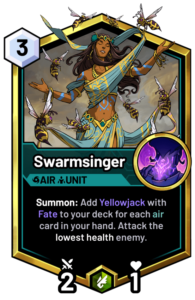
Finally we also have a Zoey deck that’s rather difficult to name. On the one hand, it plays rather similarly to Zooey builds of the past, using swarms of cheap, tempo efficient units to quickly press into the opponent. On the other hand, a chief hallmark of this build is its utilization of Air synergies, especially baner cards and Swarmsinger. Given that I find the air focus more unique, I’ve opted to call this Zoey Air. 
As for how the deck operates, it maintains a lot of the elements of traditional Zooey. Focusing on cheap tools like Gus, {{Icaru}}, and Honk, the deck beats down its opponent’s units with efficiency while gradually wearing away at their total health. One particularly interesting combo in this deck is the interaction of {{Samya’s Speed}} Gaining banner through {{Raze the Banners}}. While previously a decent tempo tool, with banner Speed scales horrifically, especially for its mana cost. The first instance of speed is a 1c deal 2 with banner, albeit at the cost of recoil. Using this twice in the same turn provides a 3c double banner that’s delivering 5 points of damage. The hero can also now make their natural attack for 3 points of damage, dealing 8 total. Of course, this combo is not a panacea, as the recoil can quickly become too much to handle against larger units. Against aggro decks however, it’s brutally effective. 
As for why the deck is not higher on the list, I believe there are a few reasons. First, aside from {{Flock}} + {{Strikestorm}}, the deck is wholly lacking good answers to the Undergrowth plays of the more dominant midrange decks. Secondly, against other aggressive decks such as Fox, the deck can be quickly ignored if Fox begins curving out cards like Khan, Heavy Cavalry, and Geode. In such an instance Zoey’s best tool works in the Fox’s favor, as the time and mana spent removing his threats just puts him closer to finding lethal with his burn tools. And finally, versus control decks, Zoey really relies on getting a robust opening that can navigate past Wisdom’s defensive tools. Cards like {{Salvage}}, {{Spiderella}}, {{Eye Spider}}, {{Strike Down}}, {{Chomp}}, and {{Avatar of Light}} all give aggro decks like Zoey a hard time, and the frequency of these answers is only bolstered by the utilization of spells like Hydrate. In any case, the primary issue is that the Zoey player universally has her work cut out for her. And, if one has read the description for Toil and Trouble, we should all know that that’s not her M.O.
So, did I get everything right? If you’ve known me long enough, you should already know that even if I did I would never admit it. But, if you want to try and make me, feel free to leave your thoughts in the comments below or message me on Discord! I am always happy to help new and experienced players, and willing to answer any (relevant) question to the best of my abilities. Special thanks to all the wonderful Fox Fang members who helped with the compilation of this report, as well as the team at Skyweaver Leagues who helped with editing. Special thanks are also owed to the amazing team at Horizon, who really do spoil us when it comes to their frequent balance patches. This game wouldn’t exist without them and all their hard work, and for that I think we’re all pretty grateful. Until next month, see y’all in Sky.

Just Add Bacon is a jovial jokester of the Skyweaver community, working on projects such as Skyweaver Leagues, and his own personal team, Fox Fang. He is also very active in the competitive scene, holding several pre-launch tournament wins and a +60% winrate in constructed conquest. His favorite decks are Horik Control and Fire Fox Aggro. “Basically, anything I can put a dragon or fox into. Or both.”



